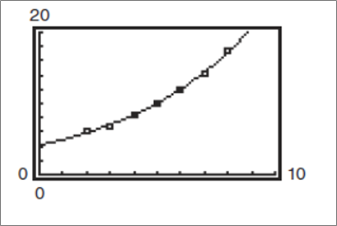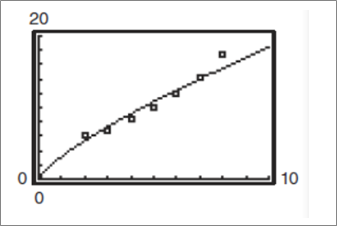
Concept explainers
a.
To find: an exponential model and a power model for the data and identify the coefficient of determination for each model using the regression feature of a graphing utility.
a.
Answer to Problem 29E
Exponential model:
Power model:
Explanation of Solution
Given information: The table shows the yearly sales estimates S (in billions of dollars).
for the online grocery shopping market for the years 2012 through 2018.
| Year | Sales, S (in billions) |
| 2012 | 6.0 |
| 2013 | 6.9 |
| 2014 | 8.4 |
| 2015 | 10.1 |
| 2016 | 12.0 |
| 2017 | 14.2 |
| 2018 | 17.5 |
Calculation:
Let t represent the year, with t = 2 corresponding to 2012 ,then the above data table can be written as below.
| Year | Sales, S (in billions) |
| 2 | 6.0 |
| 3 | 6.9 |
| 4 | 8.4 |
| 5 | 10.1 |
| 6 | 12.0 |
| 7 | 14.2 |
| 8 | 17.5 |
Using the graphing utility, the exponential model of the above table data is:
Using the graphing utility, the power model of the above table data is:
b.
To graph: each model with the data using the graphing utility.
b.
Answer to Problem 29E
Explanation of Solution
Given information: Exponential model:
Power model:
Calculation:
The graph of Exponential model:

The graph of Power model:

c.
To find: which model fits the data better.
c.
Answer to Problem 29E
The exponential model fits the data better because
Explanation of Solution
Given information:
Calculation:
The exponential model fits the data better because
Chapter 3 Solutions
PRECALCULUS W/LIMITS:GRAPH.APPROACH(HS)
- Find the accumulated amount A, if the principal P is invested at an interest rate of r per year for t years. (Round your answer to the nearest cent.) P = $3800, r = 4%, t = 10, compounded semiannually A = $ 5645.60 × Need Help? Read It SUBMIT ANSWER [3.33/6.66 Points] DETAILS MY NOTES REVIOUS ANSWERS ASK YOUR TEACHER TANAPCALC10 5.3.001.EP. PRACTICE ANOTHER Consider the following where the principal P is invested at an interest rate of r per year for t years. P = $3,100, r = 4%, t = 10, compounded semiannually Determine m, the number of conversion periods per year. 2 Find the accumulated amount A (in dollars). (Round your answer to the nearest cent.) A = $ 4604.44arrow_forwardForce with 800 N and 400 N are acting on a machine part at 30° and 60°, respectively with a positive x axis, Draw the diagram representing this situationarrow_forwardI forgot to mention to you to solve question 1 and 2. Can you solve it using all data that given in the pict i given and can you teach me about that.arrow_forward
 Calculus: Early TranscendentalsCalculusISBN:9781285741550Author:James StewartPublisher:Cengage Learning
Calculus: Early TranscendentalsCalculusISBN:9781285741550Author:James StewartPublisher:Cengage Learning Thomas' Calculus (14th Edition)CalculusISBN:9780134438986Author:Joel R. Hass, Christopher E. Heil, Maurice D. WeirPublisher:PEARSON
Thomas' Calculus (14th Edition)CalculusISBN:9780134438986Author:Joel R. Hass, Christopher E. Heil, Maurice D. WeirPublisher:PEARSON Calculus: Early Transcendentals (3rd Edition)CalculusISBN:9780134763644Author:William L. Briggs, Lyle Cochran, Bernard Gillett, Eric SchulzPublisher:PEARSON
Calculus: Early Transcendentals (3rd Edition)CalculusISBN:9780134763644Author:William L. Briggs, Lyle Cochran, Bernard Gillett, Eric SchulzPublisher:PEARSON Calculus: Early TranscendentalsCalculusISBN:9781319050740Author:Jon Rogawski, Colin Adams, Robert FranzosaPublisher:W. H. Freeman
Calculus: Early TranscendentalsCalculusISBN:9781319050740Author:Jon Rogawski, Colin Adams, Robert FranzosaPublisher:W. H. Freeman
 Calculus: Early Transcendental FunctionsCalculusISBN:9781337552516Author:Ron Larson, Bruce H. EdwardsPublisher:Cengage Learning
Calculus: Early Transcendental FunctionsCalculusISBN:9781337552516Author:Ron Larson, Bruce H. EdwardsPublisher:Cengage Learning





